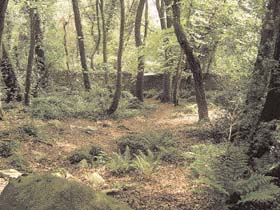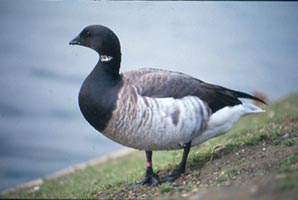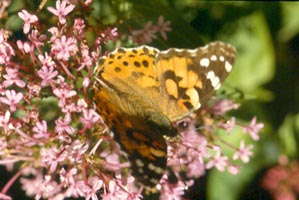|
AS PART of HERITAGE WEEK
the Dublin Field and Naturalist Club hosted a guided botanical walk around
Killiney and Dalkey hills pointing out wild flowers and native trees. It
began at the area where the Parks Department gardener Mick Kingston has planted
a new native wild flower meadow, sown with locally sourced suitable wild
flower seed. To make the soil condition suitable involves stripping off the
top soil which would be too rich for plants used to growing in natural meadows
and hedgerows. It was looking very well with delicate subtly flowered autumn
plants and the mix of seed will ensure the future rotation of native plants
in flower from early spring till late autumn. Among the seed sown are Oxeye
Daisies, Corn Marigold, Corn Chamomile, Poppy, Corn Marigold and White Campion.
Everyone was impressed with this innovation and I look forward to seeing
its results in the future. The walk moved up through the woods past the tea
house with the two Field Club botanists David Nash and Sylvia Reynolds showing
how to recognise various trees and ferns. It was fascinating to have names
put on the flowers that we walk past regularly. I must say I’d be very
hesitant trying to identify a particular type of grass species such as the
species of barley grass which we were shown growing at the base of the wall.
This grass apparently is commonly found in cities but when you have something
identified to you and given a name it always seems more interesting. A further
treat at the top of the hill when the accompanying group were allowed into
the obelisk and up the staircase to get the ultimate view of Killiney Bay
and Wicklow from the balcony. A few yards from the obelisk we were shown
a few tiny pink flowers of Thyme which was a revelation to most of us though
thankfully Mick Kingston and our botanists were well aware of it before hand.
David Nash pointed out a spot where other unusual plants had once grown but
it happened to be near one of the most scenic viewing points on the hill
and hundreds of footprints had obliterated them, possibly even my own, unknowingly,
in the past. We went on down the path past the Blackthorns, Scots and Monterey
Pines and Larches. Sylvia told us of the medicinal and culinary use of various
plants and shrubs.
One of Dalkey’s specialist plants is in fact a tree, the Irish Whitebeam,
a relative of the Rowan tree. Many of them grow along the top of the quarry
just over the wall beside the path but she showed us the variations in leaf
shape of some of them which suggested they might be hybrids. The beautiful
warm weather we’d started off with had been replaced by a cool southerly
wind and the walk had sadly reached its conclusion. I learnt to identify
a few wild flowers, forgot the names of most of them but will be willing
in the future to make the effort to get a book and try and figure out what
they are for myself.
|
Rooks
are what I always think of as the country crow. Roosting and nesting high
in trees in big colonies and swarming together in big flocks in autumn
and winter they’re the crows that follow the ploughs and tractors
their big powerful bills digging into the soil after leatherjackets, the
larval form of craneflies (Daddy Longlegs) and other insects and worms.
With their beaks pale with a featherless area around its base, suitable
for a bird that spends a lot of time with its face in the ground, and their
heavily feathered legs that resemble baggy trousers they aren’t the
most elegant of birds but I always think of their call as being one of
the most resonant of the countryside. All members of the crow family are
intelligent particularly ravens but recent findings have shown what bright
birds the rooks can be and possibly proves that one of the classic Aesop’s
fables may have been based on fact. In the tale, written more than 2,000
years ago, a crow uses stones to raise the water level in a pitcher so
it can reach the liquid to quench its thirst. |
Now a study published in Current Biology reveals that rooks,
a relative of crows,do just the same when presented with a similar situation.
The birds were shown a clear tube containing a small amount of water. Floating
upon it was an out-of-reach worm. And a pile of stones was positioned nearby.
Dr Nathan Emery, co-author of the paper, from QMUL, said: “The rooks
have to put multiple stones in the tube until the worm floats to the top.”
And the four birds did just that. Two, called Cook and Fry, raised the
water-level enough to grab the floating feast the very first time that
they were presented with the test, while Connelly and Monroe were successful
on their second attempt. Footage of the experiments shows the rooks first
assessing the water level by peering at the tube from above and from the
side, before picking up and dropping the stones into the water. The birds
were extremely accurate, using the exact number of stones needed to raise
the worm to a height where they could reach it’. There’s a
video, hopefully still available to view at ‘http://news.bbc.co.uk/2/hi/science/nature/8181233.stm
It shows the rook approaching the tube its head tilted sideways to assess
the situation as it looks at the worm before a little pile of stones are
placed near it. Then it immediately bounces over to them and begins to
drop them in the tube till the worm is within reach. The bird wasn’t
trained to do it, it just reasoned out the problem and solved it. Who’s
a clever boy then?
| Crossbills
are getting to be regular annual summer visitors to Killiney and Dalkey
hills and the surrounding area and they often land on a small stand
of spruce trees behind the car park on Dalkey Hill. Spruce are often
the only trees found in commercial plantations around the countryside
and they’ve earned a bad name for themselves. Those plantations
are usually dense, dark and lifeless and are almost depressing to walk
through but when spruces are standing alone or intermingled with other
conifers they can be quite elegant. There aren’t too many of these
trees on the hill and their cones seem to be a preference for the Crossbills.
Many of these birds come from Scandinavia; they breed early then fly
south for richer conifer harvests. Crossbills are usually in tight bouncy
flocks making a ‘chip chip’ type call and though often flying
in large numbers when they land on a tree they almost disappear, taking
on the appearance of the trees cones which they’ll |
 |
| hang
on to then tear open with their powerful beaks on which the mandibles
are crossed, specifically evolved for ripping open cones to feed on
the seeds under the little plates. The first flock I saw this summer
had about 40 birds in it including a number of male birds which are
a lovely brick red colour. The females and juvenile males are green
and resemble Greenfinches. Often one sees some type of birds or animals
when you’re looking for some other kind. The following mornings
I was carefully scanning those trees for more crossbill sightings. As
the spruce trees move up the hill they merge into Douglas Firs and sitting
out on top of one of those was a red squirrel chewing away at a cone,
one of the best views I’d ever had of one. A few days later there
were two of them on the same tree again sitting out in the open, tails
curled over their heads with a load of discarded cone pieces under them.
Didn’t see the Crossbills again but I didn’t mind. |
|
|



